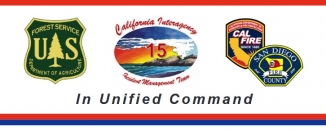 Source: CAL FIRE
Source: CAL FIRE
Logos belong respectively to U.S. Forest Service, CAL FIRE and San Diego County Fire
The “If You Fly, We Can’t” safety awareness campaign is designed to keep drone pilots away from airspace used by firefighters.
September 12, 2020 (San Diego's East County) -- Federal, state, and local wildland fire management agencies and the Federal Aviation Administration (FAA) urge members of the public not to fly “Unmanned Aircraft Vehicles (UAV)” or drones over or near wildfires. Unauthorized drone flights pose serious risks to firefighter and public safety and the effectiveness of wildfire suppression operations.
If an unauthorized drone is detected flying over or near a wildfire, fire managers may have to ground all airtankers, helicopters, and other aerial firefighting aircraft until they can confirm that the drone has left the area and they feel confident that it won’t be coming back. This can cause wildfires to become larger and more costly and to unduly threaten lives, property, and valuable natural and cultural resources.
Aerial firefighting aircraft, such as airtankers and helicopters, fly at very low altitudes, typically just a couple of hundred feet above the ground and in the same airspace as drones flown by the public. This creates the potential for a mid-air collision, or a pilot distraction that results in a crash, that could seriously injure or kill aerial and/or ground firefighters.
Temporary Flight Restrictions (TFRs) typically put in place during wildfires require manned or unmanned aircraft not involved in wildfire suppression operations to obtain permission to enter specified airspace. The FAA, U.S. Forest Service, U.S. Department of the Interior and other wildland fire management agencies consider drones, including those flown by the public for fun, to be aircraft and therefore subject to TFRs.
Members of the public should not fly drones over or near wildfires even if a TFR is not in place because of the potential for accidents and disruption of suppression operations. Individuals who are determined to have interfered with wildfire suppression efforts may be subject to civil penalties of up to $20,000 and potentially criminal prosecution, per California Penal Code Section 402(2). Members of the public who have witnessed, or who have information about an unauthorized drone flight over or near a wildfire, should contact local law enforcement.
Even though smoke or fire may not be visible, drones should not be operated in or around the wildfire area as firefighting aircraft could still be flying.
The U.S. Department of the Interior, in partnership with other federal, state, and local agencies, has developed a wildfire location data-sharing program called “Current Wildland Fires” to inform drone pilots of areas to avoid flying over or near. Additional information is available athttps://www.doi.gov/pressreleases/interior-expands-information-sharing-i...
Wildland fire management agencies are also using a variety of communication tools to connect with drone pilots. The “If You Fly, We Can’t” safety awareness campaign is designed to keep drone pilots away from airspace used by firefighters. Additional information is available at https://www.nifc.gov/drones/index.html









Comments
Go Back to a tried and true solution
Offer a bounty for identifying drone operators. Neighbors would know who is flying them . I would be happy to get $100.00 for identifying a neighbor operating a drone that creates a hazard.